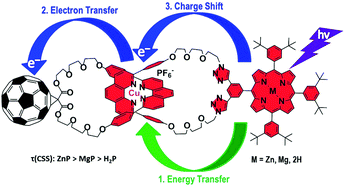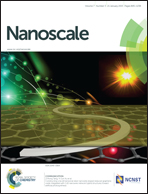Synthesis and photophysical properties of new catenated electron donor–acceptor materials with magnesium and free base porphyrins as donors and C60 as the acceptor
Abstract
A new series of nanoscale electron donor–acceptor systems with [2]catenane architectures has been synthesized, incorporating magnesium porphyrin (MgP) or free base porphyrin (H2P) as electron donor and C60 as electron acceptor, surrounding a central tetrahedral Cu(I)-1,10-phenanthroline (phen) complex. Model catenated compounds incorporating only one or none of these photoactive moieties were also prepared. The synthesis involved the use of Sauvage's metal template protocol in combination with the 1,3-dipolar cycloaddition of azides and alkynes (“click chemistry”), as in other recent reports from our laboratories. Ground state electron interactions between the individual constituents was probed using electrochemistry and UV-vis absorption spectroscopy, while events occurring following photoexcitation in tetrahydrofuran (under both aerobic and anaerobic conditions) at various wavelengths were followed by means of time-resolved transient absorption and emission spectroscopies on the femtosecond and nanosecond time scales, respectively, complemented by measurements of quantum yields for generation of singlet oxygen. From similar studies with model catenates containing one or neither of the chromophores, the events following photoexcitation could be elucidated. The results were compared with those previously reported for analogous catenates based on zinc porphyrin (ZnP). It was determined that a series of energy transfer (EnT) and electron transfer (ET) processes take place in the present catenates, ultimately generating long-distance charge separated (CS) states involving oxidized porphyrin and reduced C60 moieties, with lifetimes ranging from 400 to 1060 nanoseconds. Shorter lived short-distance CS states possessing oxidized copper complexes and reduced C60, with lifetimes ranging from 15 to 60 ns, were formed en route to the long-distance CS states. The dynamics of the ET processes were analyzed in terms of their thermodynamic driving forces. It was clear that intramolecular back ET was occurring in the inverted region of the Marcus parabola correlating rates and driving forces for electron transfer processes. In addition, evidence for triplet excited states as a product of either incomplete ET or back ET was found. The differences in behavior of the three catenates upon photoexcitation are analyzed in terms of the energy levels of the various intermediate states and the driving forces for EnT and ET processes.


 Please wait while we load your content...
Please wait while we load your content...